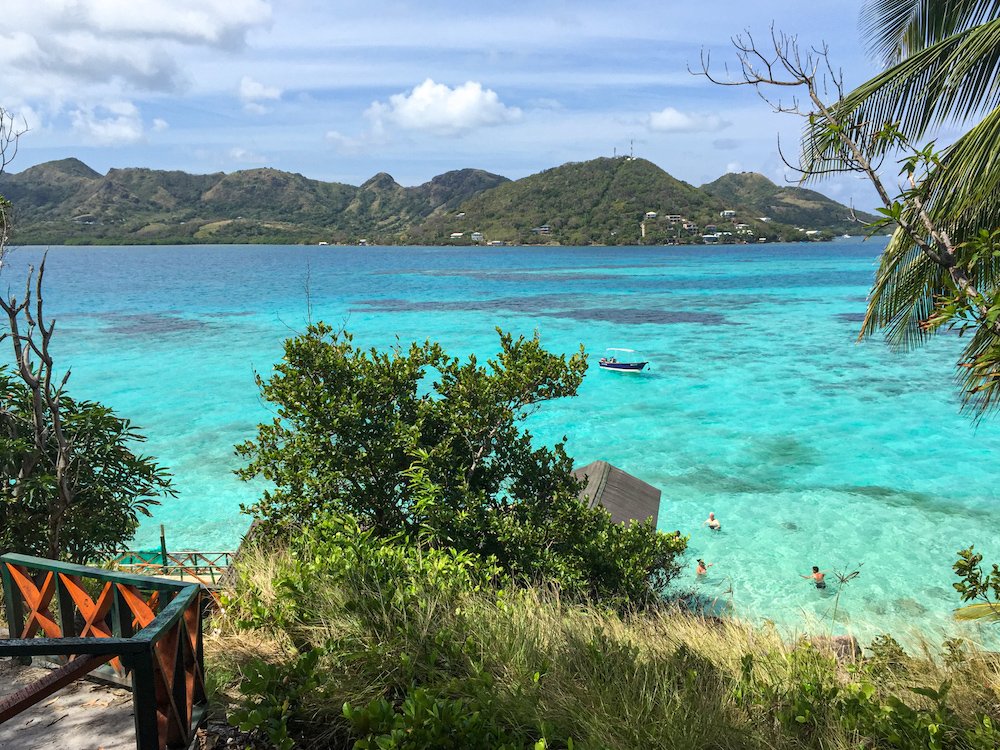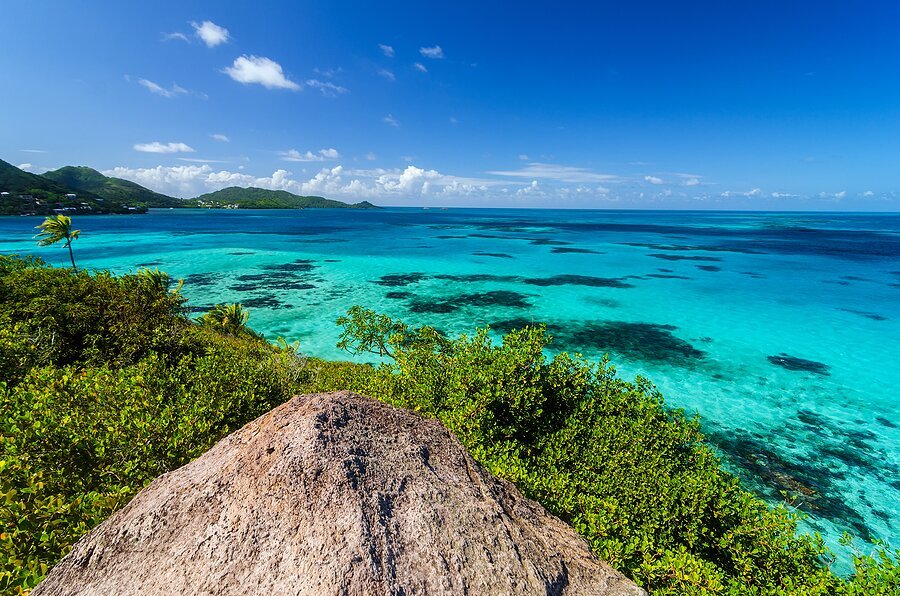
Want to discover 12 of the best Colombia islands you should visit for your next holiday?
Colombia boasts a stunning array of islands scattered along its Caribbean and Pacific coasts, each offering a unique blend of natural beauty, cultural heritage, and adventure.
From the vibrant coral reefs of San Andrés to the secluded beaches of Isla Múcura, Colombia’s islands beckon travelers with their allure and charm.
Island tourism plays a vital role in Colombia’s economy and cultural landscape.
These islands attract visitors from around the world, contributing to local livelihoods, conservation efforts, and sustainable development.
The pristine beaches, rich marine life, and diverse ecosystems of Colombia’s islands make them invaluable assets for tourism and environmental preservation.
The purpose of this article is to guide travelers through the top 12 Colombia islands to visit in 2024.
From the bustling shores of San Andrés to the tranquil retreats of Isla Fuerte, we’ll explore the highlights, attractions, and practical tips for experiencing the best that Colombia’s islands have to offer.
Whether you’re seeking adventure, relaxation, or cultural immersion, join us on a journey to discover the enchanting beauty of Colombia’s island paradises.
Now, let’s take a closer look at 12 of the best Colombia islands to visit:
1. Islas del Rosario
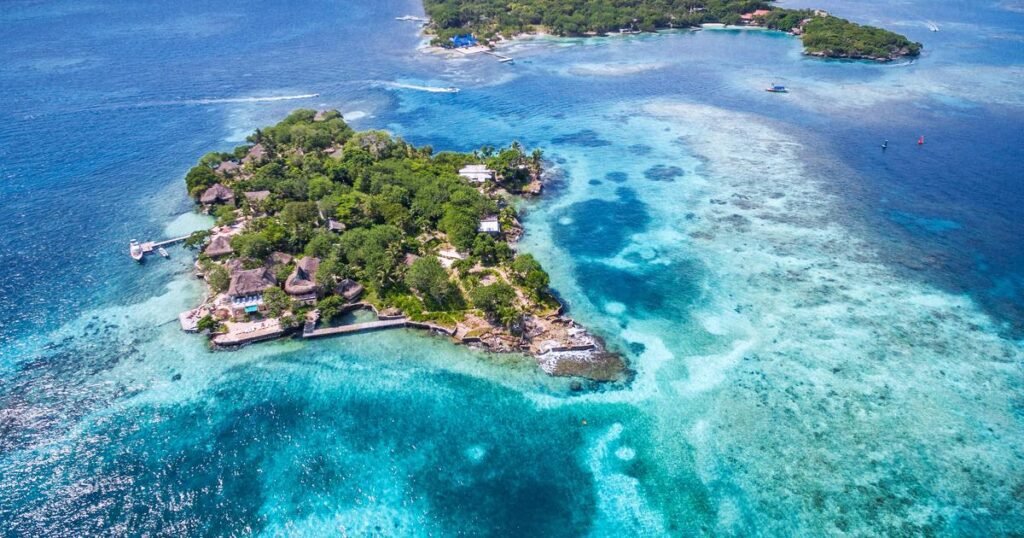
Located off the coast of Cartagena, Islas del Rosario is a breathtaking archipelago comprised of 27 small coral islands.
Accessible by boat from Cartagena’s harbor, the journey to Islas del Rosario takes approximately one hour, offering travelers a scenic voyage through the Caribbean Sea.
Islas del Rosario is renowned for its crystal-clear waters, vibrant coral reefs, and diverse marine life, making it a haven for snorkelers and scuba divers.
Visitors can explore the colorful underwater world teeming with tropical fish, rays, and sea turtles.
Additionally, the islands boast pristine beaches perfect for sunbathing, swimming, and beachcombing.
While day trips are popular, travelers seeking an extended stay can choose from a variety of accommodation options on Isla Grande, the largest island in the archipelago.
From eco-friendly resorts to rustic beachfront cabins, there’s lodging to suit every preference and budget.
Plan your visit during the week to avoid crowds, as weekends tend to be busier.
Pack essentials such as sunscreen, hats, and snorkeling gear for island adventures. Respect the delicate marine ecosystem by refraining from touching or damaging coral reefs.
Consider booking a guided snorkeling or diving tour to explore the best underwater spots.
Sample local seafood dishes and refreshing cocktails at beachfront restaurants for an authentic culinary experience.
2. San Andrés
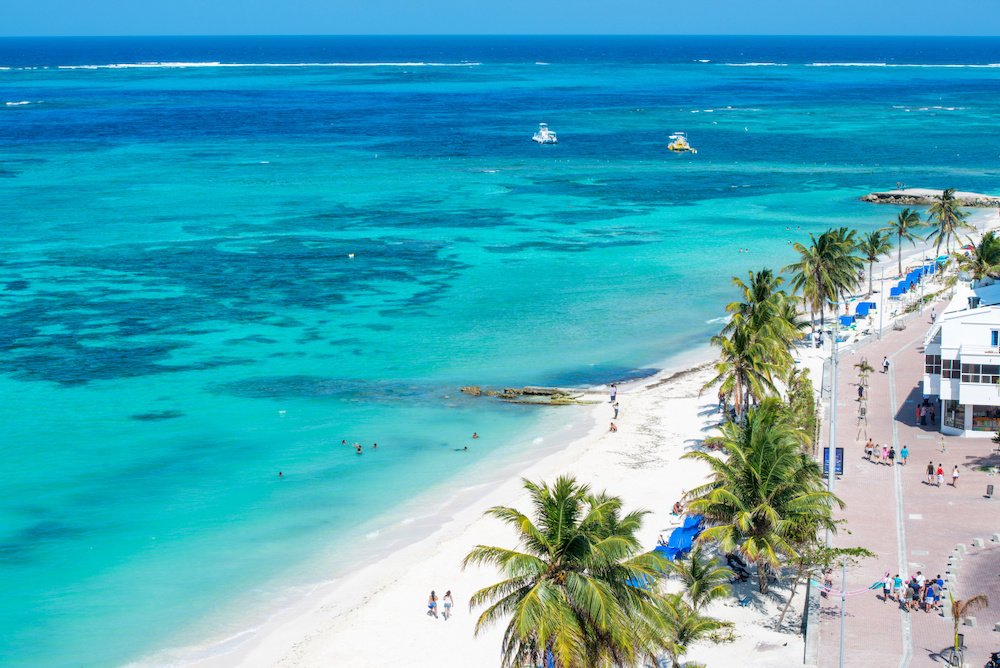
San Andrés, situated in the Caribbean Sea, is a captivating Colombian island renowned for its natural beauty, vibrant culture, and array of recreational opportunities.
San Andrés enchants visitors with its stunning white-sand beaches, turquoise waters, and lush greenery.
The island is part of the San Andrés Archipelago and is characterized by its diverse landscapes, including coral reefs, mangrove forests, and rolling hills.
San Andrés offers an array of exciting activities and water sports for visitors of all ages.
From snorkeling and scuba diving to windsurfing and jet skiing, there’s no shortage of adventures to be had in the island’s pristine waters.
Exploring the underwater world reveals colorful coral gardens, tropical fish, and even shipwrecks.
The best time to visit San Andrés is during the dry season, which typically spans from December to April.
During this period, the weather is generally sunny and dry, with calm seas ideal for water-based activities.
San Andrés experiences a tropical climate, characterized by warm temperatures averaging around 27°C (80°F) year-round.
3. Providencia
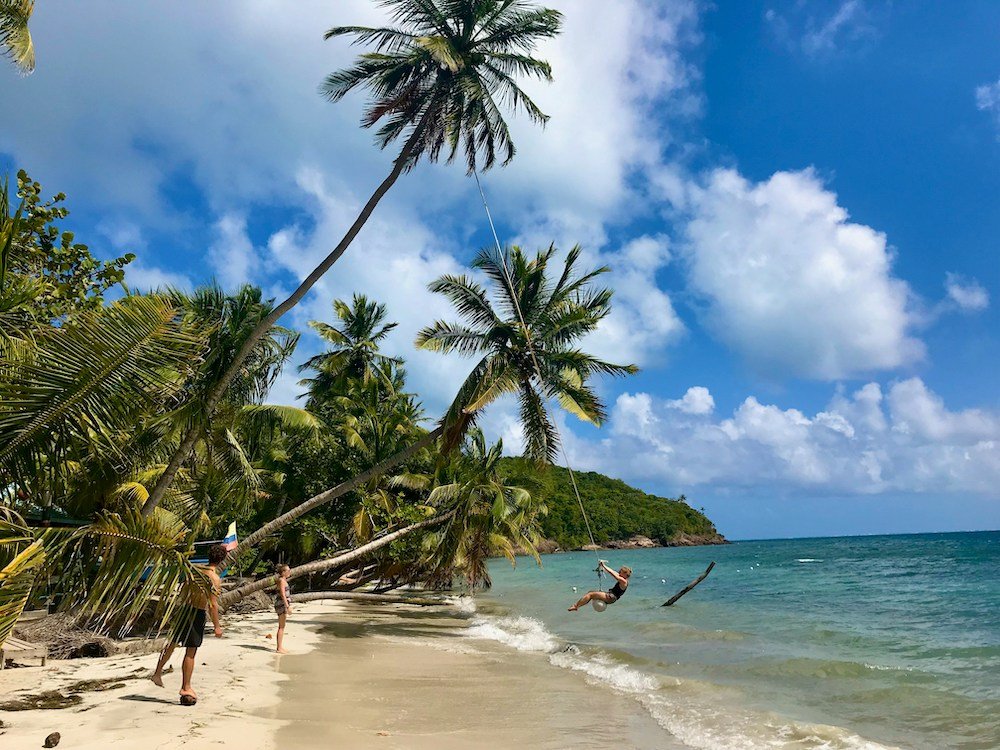
Providencia Island, nestled in the western Caribbean Sea, is a hidden gem of Colombia’s archipelago.
Known for its pristine beaches, vibrant coral reefs, and laid-back atmosphere, Providencia offers a tranquil escape from the hustle and bustle of everyday life.
Providencia is steeped in history and boasts a rich cultural heritage influenced by African, English, and Spanish traditions.
Visitors can explore the island’s historic sites, such as Fort Warwick and the Old Providence McBean Lagoon National Park, which showcase its colonial past and natural wonders.
Nature enthusiasts and thrill-seekers alike will find plenty to do on Providencia. The island offers excellent opportunities for snorkeling, diving, kayaking, and hiking.
Visitors can explore the vibrant coral reefs of Crab Cay, hike to the summit of El Pico for breathtaking panoramic views, or simply relax on the pristine beaches dotted along the coastline.
Providencia offers a range of accommodation options to suit every traveler’s preferences and budget.
From boutique hotels and eco-lodges to guesthouses and beachfront bungalows, there’s something for everyone.
Additionally, the island boasts a variety of dining establishments serving up delicious Caribbean cuisine, fresh seafood, and tropical cocktails.
4. Barú Island
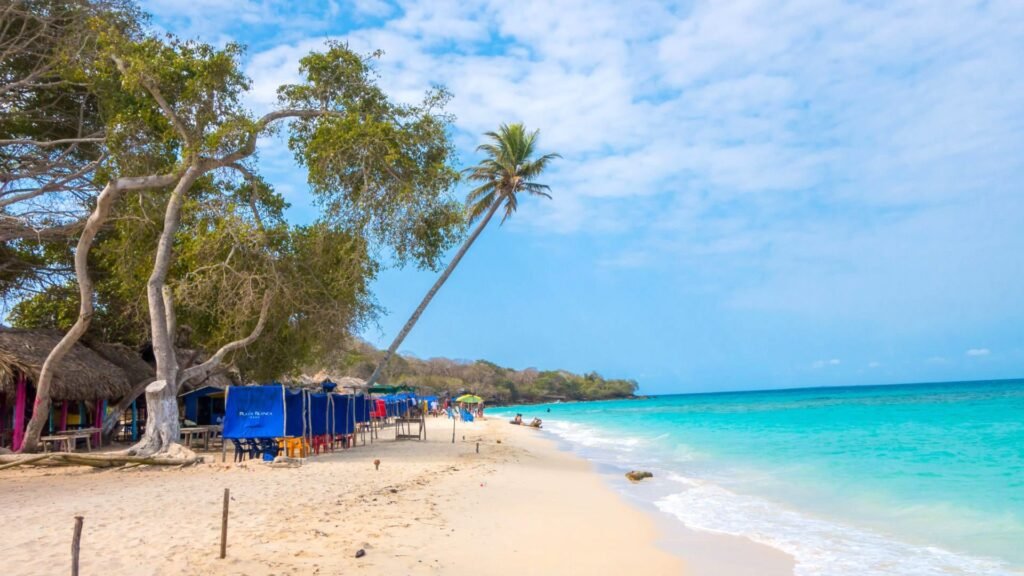
Barú Island is situated off the coast of Cartagena, making it easily accessible by boat from the mainland.
Visitors can embark on a scenic boat ride from Cartagena’s harbor, enjoying picturesque views of the Caribbean Sea along the way.
Barú Island is renowned for its stunning natural beauty and rich cultural heritage.
One of the island’s highlights is Playa Blanca, a pristine stretch of white sand beach lined with palm trees.
Other notable landmarks include the historic San Fernando Fort, which offers panoramic views of the coastline, and the Mangroves of Barú, home to diverse flora and fauna.
Barú Island boasts some of the most beautiful beaches in Colombia, offering opportunities for swimming, sunbathing, and water sports.
Visitors can snorkel in the clear turquoise waters, explore coral reefs teeming with marine life, or simply relax and enjoy the tranquil surroundings.
Tips for Visiting and Practical Information:
- Bring plenty of sunscreen, hats, and sunglasses to protect against the strong Caribbean sun.
- Consider visiting Barú during the week to avoid crowds, as weekends can be busy.
- Be respectful of the local environment and marine life by avoiding littering and disturbing coral reefs.
- Try local delicacies such as fresh seafood and tropical fruits at beachfront restaurants and food stalls.
- Be prepared for limited amenities on the island, including restroom facilities and Wi-Fi access.
5. Tierra Bomba
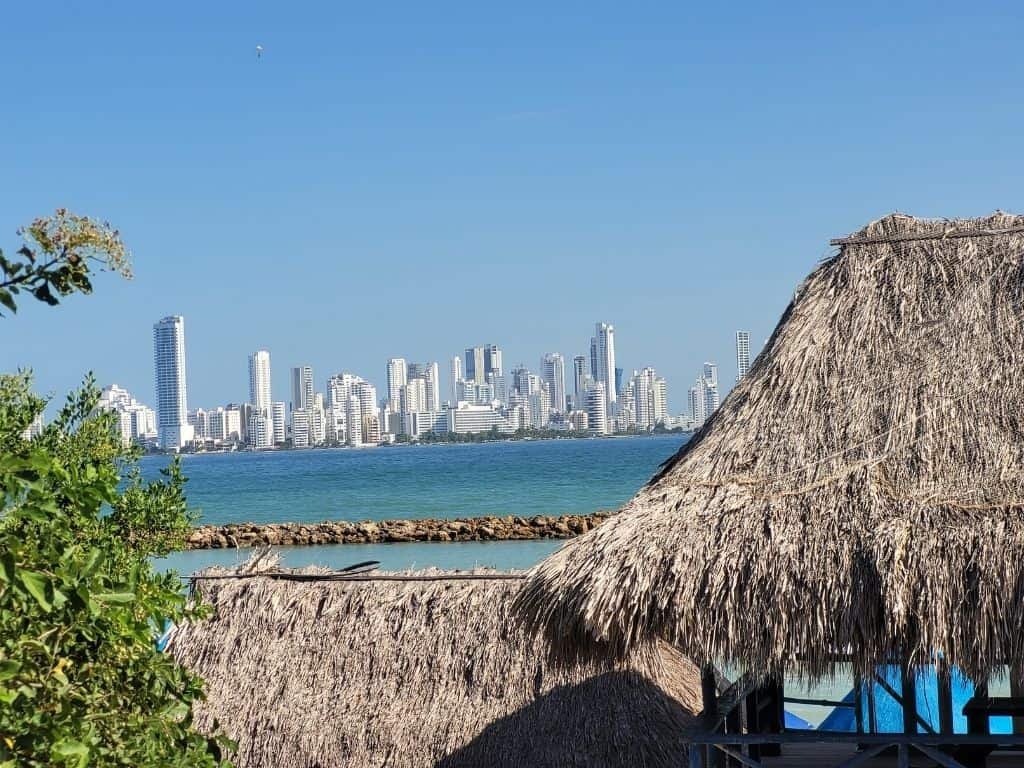
Tierra Bomba is a captivating island located just off the coast of Cartagena, Colombia.
Accessible by a short boat ride from Cartagena’s harbor, Tierra Bomba offers visitors a tranquil retreat from the bustling city. The island is known for its pristine beaches, lush landscapes, and rich cultural heritage.
Tierra Bomba is home to several noteworthy attractions and landmarks.
Visitors can explore historic sites such as the San Fernando Fort, which dates back to the colonial era and offers panoramic views of the Caribbean Sea.
The island also boasts picturesque beaches, secluded coves, and charming fishing villages waiting to be discovered.
Adventure seekers will find plenty to do on Tierra Bomba.
The island offers a range of water sports activities, including snorkeling, scuba diving, jet skiing, and parasailing.
Visitors can also embark on guided kayak tours to explore the island’s pristine coastline and hidden coves.
Tierra Bomba offers a variety of accommodation options ranging from boutique hotels to beachfront villas and eco-lodges.
Visitors can choose to stay in charming guesthouses nestled amidst lush tropical gardens or opt for luxury resorts offering panoramic ocean views.
When it comes to dining, Tierra Bomba boasts a vibrant culinary scene with restaurants serving up fresh seafood, traditional Colombian dishes, and international cuisine.
6. Gorgona Island
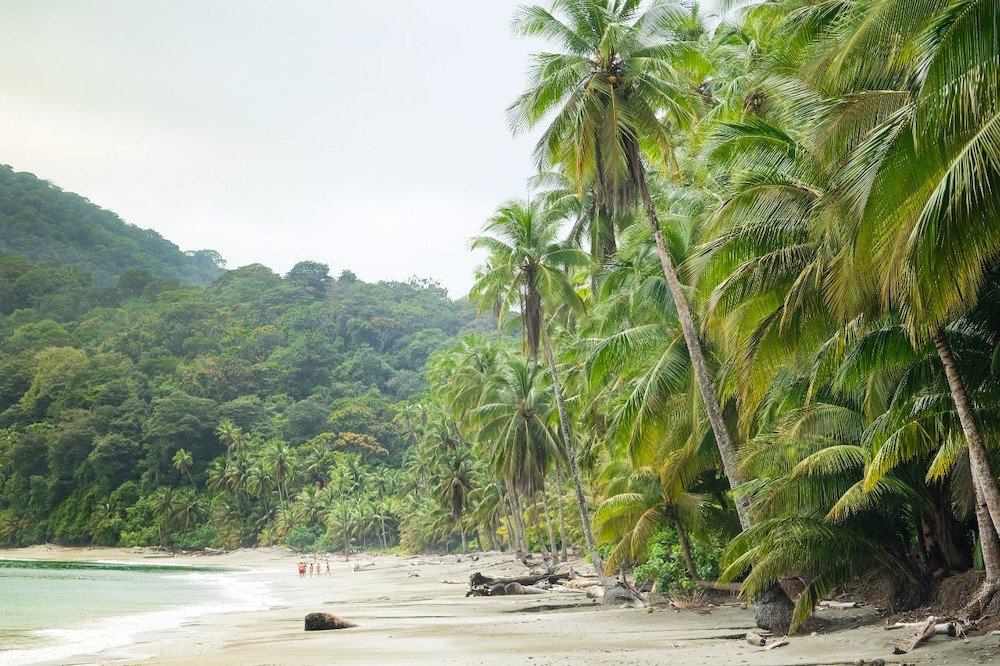
Gorgona Island, located in the Pacific Ocean off the coast of Colombia, is a pristine natural paradise renowned for its biodiversity and ecological significance.
Gorgona Island is home to a rich variety of wildlife and nature reserves, making it a haven for nature enthusiasts and conservationists alike.
The island is a designated national park and UNESCO World Heritage Site, protecting its unique ecosystems and diverse habitats.
Visitors to Gorgona Island can explore its lush rainforests, home to rare species of flora and fauna, including howler monkeys, colorful birds, and endemic plant species.
The island’s pristine beaches provide nesting grounds for sea turtles, while its surrounding waters teem with marine life, including dolphins, whales, and tropical fish.
Snorkeling and diving enthusiasts will find a treasure trove of underwater wonders around Gorgona Island.
The island’s coral reefs are among the most biodiverse in the world, offering vibrant marine ecosystems to explore.
Visitors can swim alongside colorful reef fish, encounter majestic manta rays, and marvel at the beauty of coral gardens.
Gorgona Island is committed to sustainable tourism efforts and conservation projects aimed at preserving its natural heritage.
Park rangers and environmentalists work tirelessly to protect the island’s fragile ecosystems, monitor wildlife populations, and promote responsible visitor practices.
Through education and outreach programs, Gorgona Island strives to raise awareness about the importance of biodiversity conservation and environmental stewardship.
7. Isla de la Piragua

Isla de la Piragua, nestled in the Caribbean Sea off the coast of Colombia, is a hidden gem known for its natural beauty, cultural richness, and warm hospitality.
Isla de la Piragua is accessible by boat from various ports along Colombia’s Caribbean coast. The island’s remote location and pristine landscapes make it a peaceful retreat for travelers seeking tranquility and adventure.
Isla de la Piragua captivates visitors with its breathtaking natural landscapes and scenic spots.
From palm-fringed beaches to lush mangrove forests, the island offers endless opportunities for exploration and relaxation.
Visitors can hike along nature trails, kayak through tranquil waters, or simply unwind amidst the island’s serene surroundings.
The rich cultural heritage of Isla de la Piragua is reflected in its vibrant community and traditional cuisine. Visitors can immerse themselves in the island’s local culture by participating in cultural events, such as traditional dance performances and artisanal crafts workshops. The island’s cuisine features fresh seafood, tropical fruits, and flavorful dishes influenced by Afro-Caribbean and indigenous culinary traditions.
Traveling to Isla de la Piragua requires careful planning and preparation. Pack light and comfortable clothing suitable for tropical weather conditions.
Bring insect repellent and sunscreen to protect against mosquitoes and sun exposure.
Engage with local residents and learn about their customs and traditions.
Explore the island’s hidden gems, such as secluded beaches and pristine coves, for a truly authentic experience.
Support local businesses and artisans by purchasing handmade crafts and souvenirs.
8. Isla Fuerte
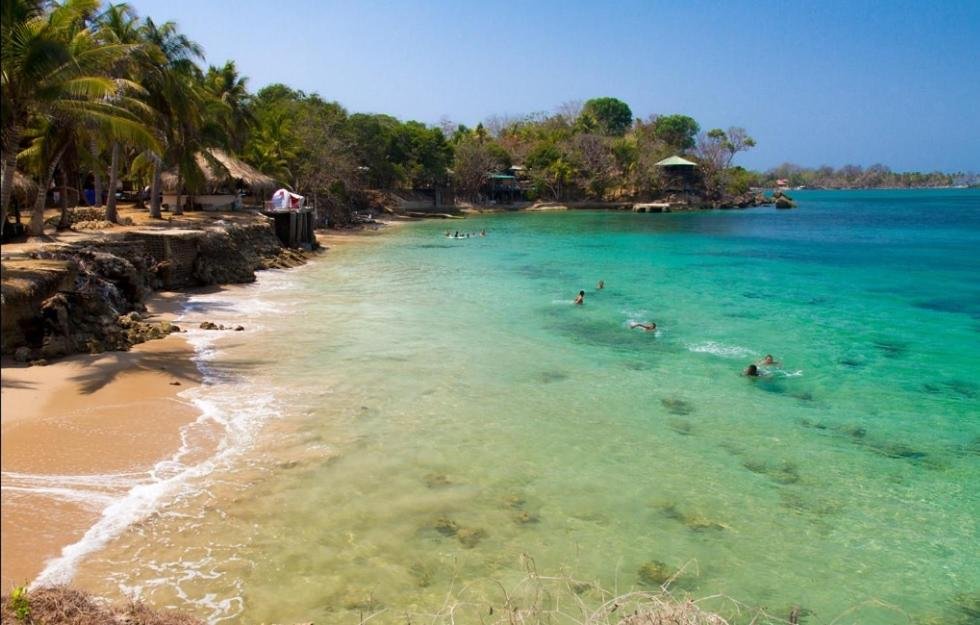
Isla Fuerte, located in the Caribbean Sea off the coast of Colombia, is a pristine island paradise known for its natural beauty, rich biodiversity, and sustainable tourism initiatives.
Isla Fuerte is a haven for ecotourism and environmental conservation efforts.
The island is home to lush mangrove forests, vibrant coral reefs, and diverse marine life, making it an ideal destination for nature enthusiasts and adventure seekers alike.
Visitors to Isla Fuerte can participate in various eco-friendly activities, such as birdwatching, hiking, and snorkeling, while learning about the island’s unique ecosystems and conservation challenges.
The island’s pristine beaches and crystal-clear waters offer endless opportunities for outdoor recreation and relaxation.
From swimming and sunbathing to kayaking and paddleboarding, visitors can immerse themselves in the island’s tranquil surroundings and connect with nature.
Isla Fuerte offers a range of accommodation options, including eco-lodges, guesthouses, and community-owned cabins, providing visitors with authentic and sustainable lodging experiences.
Community tourism initiatives play a vital role in supporting local livelihoods and preserving the island’s cultural heritage.
Visitors can engage with local residents, participate in cultural activities and workshops, and contribute to community development projects during their stay on Isla Fuerte.
9. Islas del Rosario
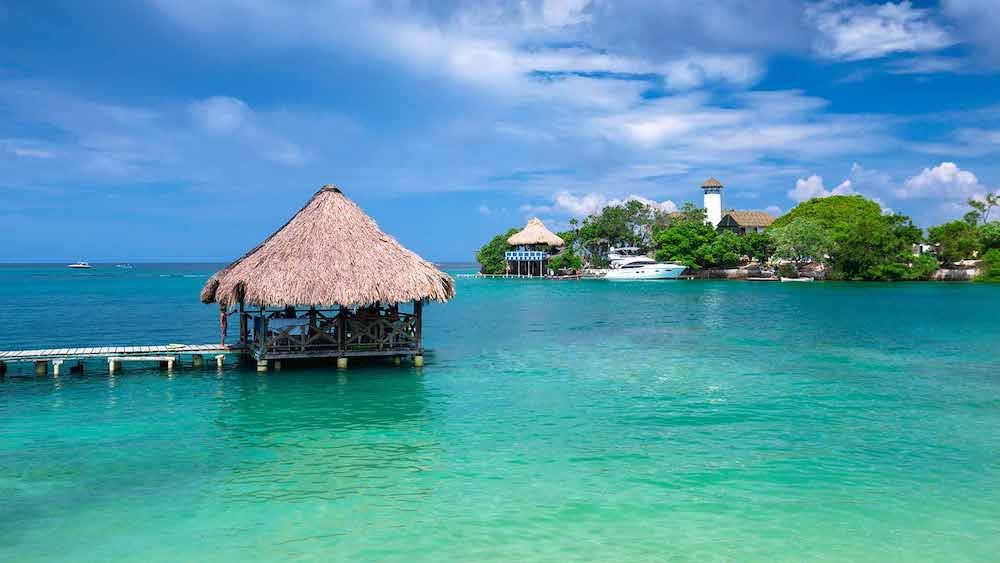
Islas del Rosario, located off the coast of Cartagena in the Caribbean Sea, is a captivating archipelago renowned for its historical significance, marine biodiversity, and scenic beauty.
Islas del Rosario holds a rich historical background and cultural significance.
The islands served as a strategic outpost during the colonial era, with Fort San Fernando and other historic landmarks bearing witness to centuries of maritime history and trade in the region.
The archipelago is home to a diverse range of marine life and protected areas, making it a haven for biodiversity and conservation efforts.
Coral reefs, seagrass beds, and mangrove forests support a wealth of marine species, including colorful fish, sea turtles, and delicate coral formations.
Visitors to Islas del Rosario can explore designated marine parks and protected areas, such as the Rosario and San Bernardo Corals National Natural Park, to learn about the importance of marine conservation and sustainable tourism practices.
Snorkeling and diving opportunities abound in Islas del Rosario, offering visitors a chance to discover the underwater wonders of the Caribbean Sea.
Crystal-clear waters, vibrant coral reefs, and shipwrecks teeming with marine life await exploration, providing unforgettable experiences for snorkelers and divers of all skill levels.
For those seeking adventure and exploration, day trips and island hopping tours are popular options for experiencing the beauty and diversity of Islas del Rosario.
Visitors can embark on guided excursions to multiple islands within the archipelago, each offering its own unique attractions, from secluded beaches and hidden coves to bustling coral reefs and historic landmarks.
10. Isla Grande
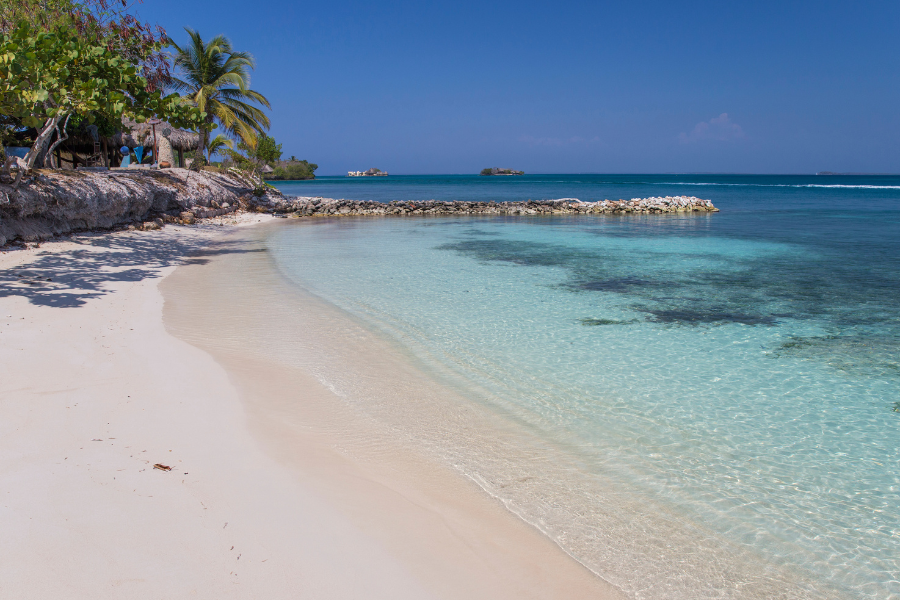
Isla Grande, the largest island in the Islas del Rosario archipelago, is a tropical paradise located off the coast of Cartagena, Colombia.
With its stunning beaches, lush landscapes, and abundance of outdoor activities, Isla Grande offers visitors a true Caribbean escape.
Isla Grande is nestled in the heart of the Caribbean Sea, just a short boat ride from Cartagena’s harbor.
Its convenient location makes it a popular destination for day trips and weekend getaways, offering travelers a chance to experience the beauty and tranquility of island life.
The island’s pristine beaches and natural attractions are among its main draws.
From secluded coves to expansive stretches of white sand, Isla Grande boasts some of the most picturesque coastlines in Colombia.
Visitors can unwind on the beach, swim in crystal-clear waters, or explore hidden caves and rock formations along the shore.
For adventure enthusiasts, Isla Grande offers a variety of thrilling activities and recreational opportunities.
Snorkeling and diving are popular pastimes, allowing visitors to discover colorful coral reefs, exotic fish, and other marine life beneath the waves.
Kayaking, paddleboarding, and jet skiing are also available for those seeking adrenaline-pumping adventures on the water.
Before visiting Isla Grande, there are a few insider tips and things to know. Be sure to bring sunscreen, hats, and sunglasses to protect against the Caribbean sun.
Pack insect repellent to ward off mosquitoes, especially in the evenings. Consider staying overnight on the island to fully immerse yourself in its natural beauty and tranquility.
And don’t forget to support local businesses by dining at beachfront restaurants and purchasing handmade souvenirs from island vendors.
11. Malpelo Island
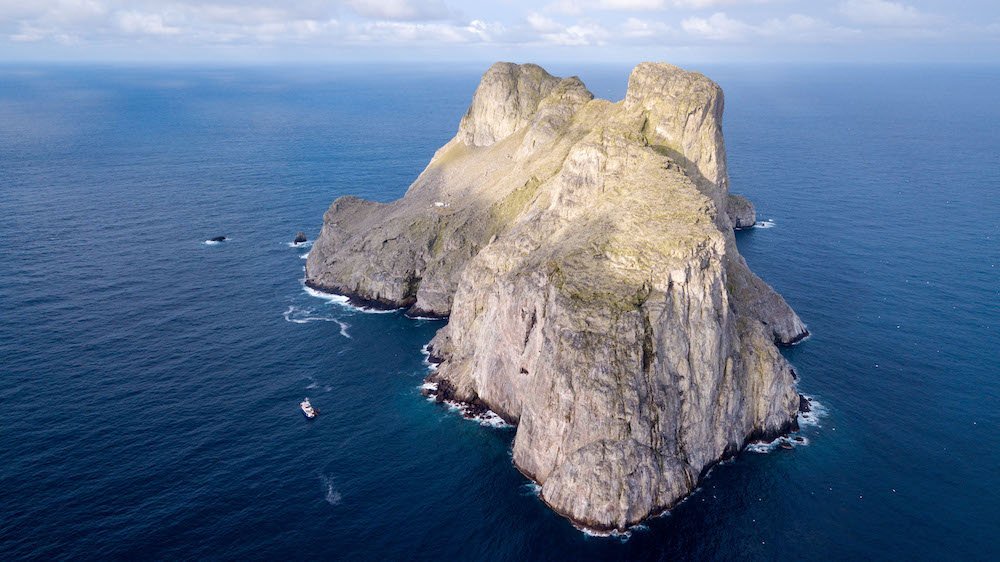
Malpelo Island, located in the Pacific Ocean approximately 500 kilometers off the coast of Colombia, is a remote and uninhabited island renowned for its pristine marine ecosystems and extraordinary biodiversity.
Malpelo Island’s remote location and rugged terrain make it one of the most challenging destinations to access.
The island is uninhabited and has no permanent infrastructure, with limited access available only to scientific researchers and authorized dive expeditions.
Its isolation has helped preserve its pristine natural environment and protect its delicate ecosystems from human impact.
Beneath the surface of the surrounding waters lies a marine paradise teeming with life.
Malpelo Island is home to one of the largest aggregations of sharks in the world, including hammerheads, silky sharks, and whale sharks.
Diving around the island offers unparalleled opportunities to encounter these majestic creatures, along with other marine species such as manta rays, dolphins, and sea turtles.
Malpelo Island holds immense scientific significance as a natural laboratory for marine research and conservation.
Scientific expeditions to the island are conducted to study its unique ecosystems, monitor marine populations, and assess the impact of human activities on the marine environment.
Researchers also conduct studies on shark behavior, migratory patterns, and the role of apex predators in marine ecosystems.
Due to its remote location and fragile ecosystems, responsible tourism practices are essential for preserving Malpelo Island’s natural heritage.
Authorized dive operators adhere to strict guidelines to minimize their impact on the environment and ensure the safety of both visitors and marine life.
Conservation efforts focus on protecting the island’s marine reserves, enforcing regulations against illegal fishing, and raising awareness about the importance of marine conservation among local communities and international stakeholders.
12. Isla Múcura
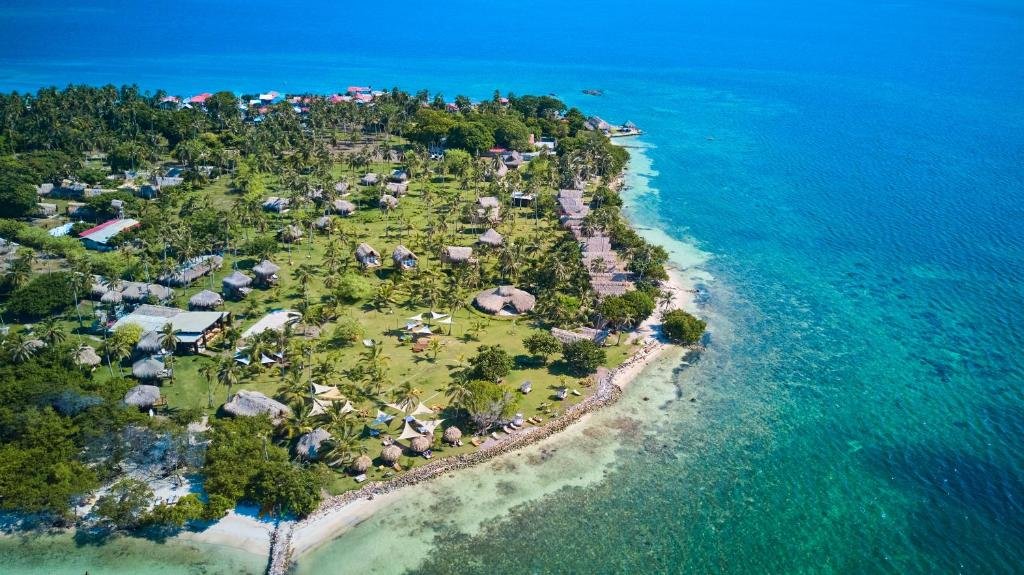
Isla Múcura is a picturesque island nestled in the San Bernardo Archipelago in the Caribbean Sea, off the coast of Colombia.
With its pristine beaches, crystal-clear waters, and laid-back atmosphere, Isla Múcura is a hidden gem waiting to be discovered by travelers seeking a tropical paradise.
Isla Múcura is part of the San Bernardo Archipelago, a collection of small islands and cays renowned for their natural beauty and marine biodiversity.
The island is located approximately 50 kilometers from the port city of Cartagena, making it easily accessible by boat or ferry.
Isla Múcura boasts some of the most stunning beaches in Colombia, with powdery white sand and calm turquoise waters.
Visitors can relax on the beach, soak up the sun, and enjoy panoramic views of the Caribbean Sea.
The island’s coastline is dotted with mangrove forests, rocky coves, and hidden lagoons waiting to be explored.
The crystal-clear waters surrounding Isla Múcura offer excellent opportunities for snorkeling, allowing visitors to discover colorful coral reefs, tropical fish, and other marine life.
Kayaking is another popular activity, allowing travelers to explore the island’s coastline and discover secluded beaches and hidden coves.
Isla Múcura offers a range of accommodation options to suit every traveler’s preferences, from boutique hotels and eco-lodges to rustic beachfront cabanas.
The island amenities include restaurants serving fresh seafood and traditional Colombian cuisine, beach bars offering refreshing cocktails, and shops selling handmade crafts and souvenirs.
Visitors to Isla Múcura can indulge in the island’s delicious cuisine, which features fresh seafood, tropical fruits, and flavors inspired by Caribbean and Colombian culinary traditions.
Dining experiences range from casual beachfront eateries to fine dining restaurants, offering a taste of the island’s vibrant culinary scene.
Tips for Exploring Isla Múcura and Nearby Islands:
- Pack light and comfortable clothing suitable for tropical weather conditions.
- Bring sunscreen, hats, and sunglasses to protect against the sun’s rays.
- Explore the island’s hidden gems, such as secluded beaches and snorkeling spots.
- Participate in guided tours and excursions to discover the natural beauty and cultural heritage of Isla Múcura and nearby islands.
Conclusion
In this article, we’ve explored twelve of Colombia’s most captivating islands, each offering its own unique charm and allure.
From the pristine beaches of Isla Múcura to the remote wilderness of Malpelo Island, Colombia’s islands are a paradise waiting to be discovered.
Island tourism plays a crucial role in Colombia’s travel industry, offering visitors a chance to explore the country’s rich cultural heritage and natural beauty.
The diverse landscapes, vibrant ecosystems, and warm hospitality of Colombia’s islands make them an ideal destination for travelers seeking adventure, relaxation, and cultural immersion.
As travelers plan their adventures for 2024 and beyond, we encourage them to consider Colombia’s diverse island destinations.
Whether you’re seeking adventure, relaxation, or cultural immersion, Colombia’s islands offer something for everyone.
From the bustling streets of San Andrés to the tranquil shores of Isla Múcura, each island has its own unique character and charm waiting to be explored.
Embark on a journey to discover Colombia’s hidden treasures, immerse yourself in the vibrant cultures and traditions of its islands, and create memories that will last a lifetime.
With its stunning landscapes, rich biodiversity, and warm hospitality, Colombia is truly a destination like no other.

FAQ’s About Colombia Islands:
How many islands does Colombia have?
Colombia is home to over 1,000 islands, each with its own unique characteristics and attractions.
These islands are spread across the Caribbean Sea and the Pacific Ocean, offering a diverse range of landscapes and experiences for visitors to explore.
What is the best island to stay at in Colombia?
The best island to stay at in Colombia depends on individual preferences and interests.
Some popular choices among travelers include San Andrés for its stunning beaches and vibrant nightlife, Isla Múcura for its tranquility and natural beauty, and Providencia for its pristine landscapes and rich cultural heritage.
What is the largest island in Colombia?
The largest island in Colombia is Isla de Providencia, also known as Providencia Island.
Located in the Caribbean Sea, Providencia is part of the Archipelago of San Andrés, Providencia, and Santa Catalina.
What vacation island is off the coast of Colombia?
Several vacation islands are off the coast of Colombia, including San Andrés, Providencia, Isla Múcura, Isla Barú, and Islas del Rosario.
These islands offer a variety of attractions, including stunning beaches, vibrant coral reefs, and cultural experiences.
What is the tiny island in Colombia?
One of the tiny islands in Colombia is Isla Múcura, located in the San Bernardo Archipelago in the Caribbean Sea.
Isla Múcura is known for its pristine beaches, crystal-clear waters, and laid-back atmosphere.
What is the small island off of Colombia?
Several small islands are off the coast of Colombia, including Isla Múcura, Isla Barú, and the Islas del Rosario.
These islands offer picturesque landscapes, rich biodiversity, and opportunities for water sports and relaxation.
What is the island between Colombia and Venezuela?
The island between Colombia and Venezuela is Isla de San Martín, also known as Isla Margarita.
Isla Margarita is part of Venezuela’s Nueva Esparta state and is located in the Caribbean Sea.
What are the islands between Panama and Colombia?
The islands between Panama and Colombia are known as the San Blas Islands, also called the Guna Yala Islands.
This archipelago consists of over 300 islands and cays, many of which are uninhabited or sparsely populated.
The San Blas Islands are known for their pristine beaches, turquoise waters, and vibrant indigenous culture.
What is Colombia’s island in the Caribbean?
Colombia’s island in the Caribbean Sea is San Andrés.
San Andrés is part of the Archipelago of San Andrés, Providencia, and Santa Catalina, and it is known for its stunning beaches, clear waters, and vibrant culture.
